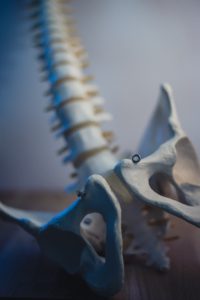Pelvic Girdle Pain
 What is pelvic girdle pain? It is pain on the backside of your pelvis by your sacroiliac joints (SIJ). It can occur separately or with low back pain or pain on the pubic symphysis (front of your pelvis). The pelvis is made up of 2 bones that join together at the base of the spine (sacrum) and in the front (pubic bone). It is strong enough to support the body and flexible enough to absorb the impact of your feet hitting the ground. Pelvic girdle pain is most commonly seen during pregnancy and postpartum and is more common in women than men. This can also be caused by trauma or arthritis.
What is pelvic girdle pain? It is pain on the backside of your pelvis by your sacroiliac joints (SIJ). It can occur separately or with low back pain or pain on the pubic symphysis (front of your pelvis). The pelvis is made up of 2 bones that join together at the base of the spine (sacrum) and in the front (pubic bone). It is strong enough to support the body and flexible enough to absorb the impact of your feet hitting the ground. Pelvic girdle pain is most commonly seen during pregnancy and postpartum and is more common in women than men. This can also be caused by trauma or arthritis.
Pelvic girdle pain is NOT the same as low back pain. This is because the pain originates from the pelvis rather than the low back and spine. It does not present with sensory changes or weakness. It is possible to have one sided or double-sided pelvic girdle pain in regards to the sacroiliac joints.
What Can Cause Pelvic Girdle Pain?
Although the biomechanical cause is uncertain, the cause may be an imbalance of the coordination of ligaments, muscles, and joints in the posterior part of the pelvis. Changes in hormones, especially during pregnancy, may cause this to occur. However, it has been shown that there is no significant difference between women who develop joint laxity and those who do not. A relationship does exist between SIJ laxity and pelvic pain. Women with more laxity or range of motion can have decreased pain if they have adequate motion control.
It can also be possible that stabilizing TOO much can be a cause of pelvic girdle pain. Remember, our pelvis is part stability and part flexibility! Some people can have a tendency to be a butt clencher or ab clencher. Some people have muscles that are too tight in their pelvic floor or back. Too much muscle tension makes it difficult for the muscles to relax. That causes us to lose the flexibility we need within our pelvic girdle.
What Can Help?
There are many factors that can cause pelvic girdle pain. Every situation depends on the person. It is best to have an evaluation by a physical therapist. We will put you through a series of tests and movements. This will confirm if it is true pelvic girdle pain or if the pain is coming from somewhere else. Depending on the sensitivity of pain, you may need to modify some movements. These modifications can include standing on one leg, crossing legs, leg position while turning in bed, or lunging. It will depend on your symptoms! Sometimes you can continue to perform your same activities by learning how to stabilize with your core muscles or teaching your muscles how to relax. The best strategy is a combination of manual therapy, stabilization exercises, use of stabilizing tools such as an SI belt, and education of any lifestyle or biomechanical modifications.
Remember, it is not a one-size-fits-all when it comes to rehabilitation, especially for pelvic girdle pain. If you have more questions or are experiencing pain that sounds similar to this, reach out to our pelvic health physical therapist at MOSAIC! To learn more, visit the Pelvic Health Rehabilitation Center or read the Physical Therapy Standard of Care.
